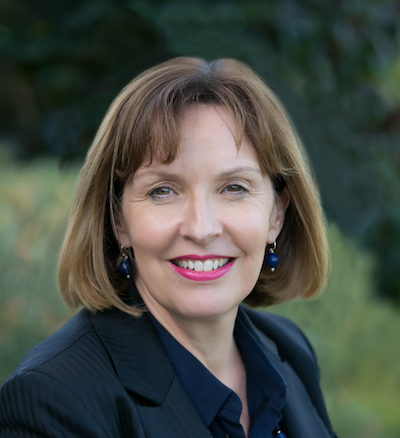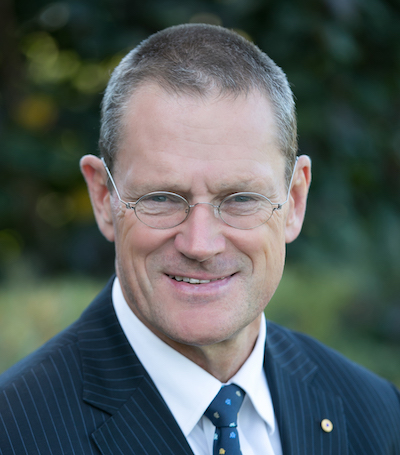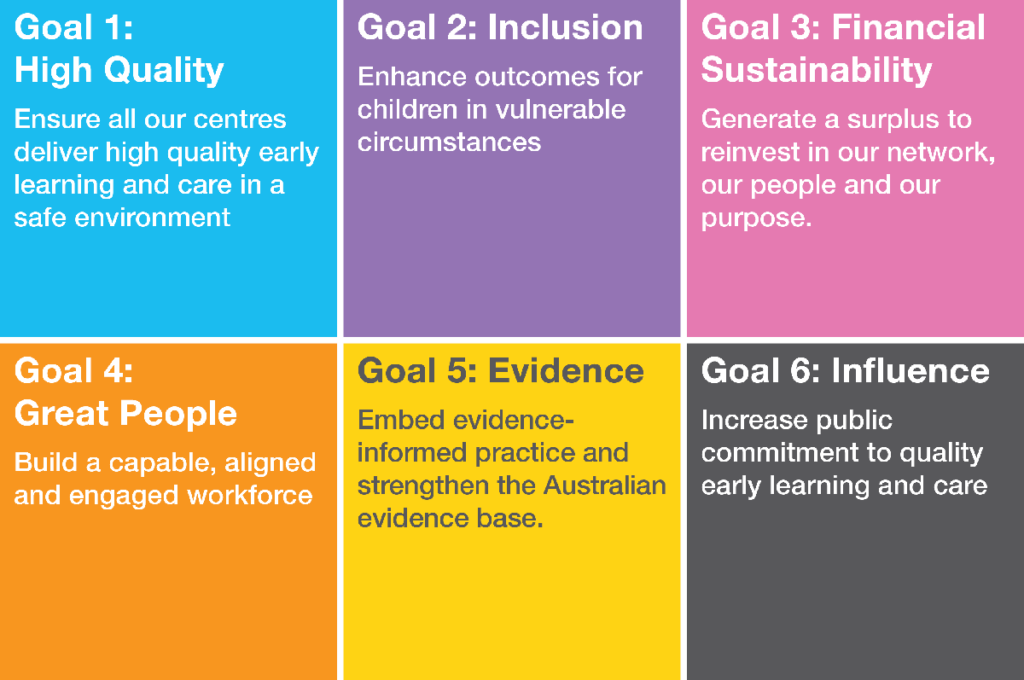
Goodstart: steering a social enterprise for impact
SVA’s incoming CEO, Suzie Riddell, asks Goodstart how, as a social enterprise, it balances its commercial and social goals; and what role influencing the system plays in meeting its purpose.

- One of the most important ways that Goodstart has fulfilled its purpose as a social enterprise is by developing a strategy at the start and being very clear about the organisation’s purpose and goals.
- The social and commercial goals complement and reinforce each other in many ways.
- Having a good balance in board composition of skills and experience supports the balancing of the organisation’s goals.
Goodstart Early Learning [Goodstart] is one of Australia’s largest not-for-profit social enterprises. Its turnover in 2018 exceeded $1 billion, the proceeds of which are re-invested into providing quality early learning and delivering on its vision of giving Australia’s children the best possible start in life.
The organisation was formed in 2009 by a syndicate of four not-for-profits buying out the bankrupt ABC Learning business with a vision of transforming early childhood learning in Australia. (See Goodstart: a story of impact investing for the story behind the buyout.)
Serving a social mission
As a large social enterprise, now with 644 centres nationally attended by close to 71,000 children, how does Goodstart go about achieving its social mission and balancing the commercial and social goals – which at times must be in competition?

One of the most important things, says Goodstart’s CEO Julia Davison, was developing a strategy and being really, really clear about the organisation’s purpose and goals.
It was the first thing Davison did when she joined the organisation in 2010.
“It was my job when I arrived to develop the vision, the purpose, strategy and goals, and to find a way of shifting the culture of the organisation to actually deliver on these.”
Building on the founders’ work, Davison and the board created the purpose, established three goals – financial stability, quality and inclusion – as well as the guiding principles to support those goals.
“We developed very concrete measures and KPIs against each of the goals with a brief narrative and compelling case for change for each of them,” says Davison.

“The narrative for financial stability was: ‘No money, no mission; more money, more mission’.
“Given our predecessor, ABC Learning had gone broke, it was very easy to see that if the business wasn’t financially viable, it wouldn’t deliver on its purpose.”
Goodstart’s current Chair, Michael Traill (and previously CEO of SVA, one of the founding not-for-profits) concurs: “From the beginning, we all recognised that if we didn’t perform commercially – meeting financial and business objectives – then we would not have the capacity to do what we wanted to do in terms of the social purpose investment.
“You can do a lot of good work, but if you fail commercially, it can blow up.”
He also remembers that the founders had felt more was at stake in proving the possibility of the venture.
“If we couldn’t demonstrate we could run the largest operator of early learning and childcare centres at scale with business disciplines for social purpose, then we’d fail.”
And that ethos, he says, hasn’t changed substantially.
Equally important as financial stability in the early strategy – Goodstart used the metaphor of a three-legged stool – were the other two goals: quality and inclusion.

A commitment to high quality early learning and care was deemed totally necessary for the organisation to serve its vision of all Australia’s children having the best start in life. This is initially where it focused its advocacy efforts (see below).
The inclusion goal was articulated as ‘No child will be excluded’ – setting a very different marker in the sand for the industry which could and would exclude children who had additional needs on the basis that they required additional resources.
I realised, we’re doing good things in everything we do every day in our network.
Balancing commercial and social goals
Davison understands that the social and commercial goals in many ways complement and reinforce each other.
“Initially, I started off thinking that you’d generate a surplus over here, and then invest over there on good things. But I realised, we’re doing good things in everything we do every day in our network.”
As the organisation has grown it’s been easier to see that more money means more mission.
“Initially we were repaying the loan and had a backlog of things to spend on as the centres and technology were run down. Once the loan was paid off, it became clearer what we’re investing in.”
As occupancy increased and the organisation became more financially stable, Goodstart has been able to pay staff more (wages are currently above award), invest in the physical environment (over the last three years 506 of its 644 centres have been upgraded or painted), provide resources to advocate at a policy level, fund better professional development, and invest in research and building the evidence-base. While price increases to families over the last two years is lower than sector average.
Board composition
In balancing the organisation’s goals, both Davison and Traill acknowledge the importance of the board composition.
“The Goodstart founders were very conscious about having a board with a balance of depth in the commercial, education and social sectors,” says Davison.
Traill agrees that there’s been respect and understanding around the board table that both commercial and social goals are needed.
If I didn’t feel the tension between these goals, we would be out of balance.
It is easy to see how setting a bar for, and providing, high quality early learning will attract more families, increase occupancy and support commercial goals – a virtuous cycle. However, investing in inclusion and not turning any child away, might not directly support commercial KPIs.
For example, Goodstart has as one of its inclusion measures, the percentage vulnerable children who have attended one of its centres. This often requires more resourcing and so increases the labour hours per attendance – which is reflected in financial measures.
Davison stresses that understanding the connection between social purpose goals and commercial goals is really important. “You’ve got to keep the two balanced.”
“If I didn’t feel the tension between these goals, we would be out of balance. If I didn’t have the people who are really passionate about children’s outcomes and quality feeling that we’re perhaps tipping it in the commercial side, or the commercial people saying we’re not commercial enough, then we’ve gone out of balance one way or the other.”
The solution is in having the right board balance, skill set and experience.
Traill grants that managing those tensions is always challenging. “It’s the balanced scorecard stuff. In terms of determining those priorities, you’re going to have plenty of occasions when you’ve got some difference of view and some tension. So the ability to mediate that in a respectful way is really important. And that’s happened pretty effectively.”
“The solution is in having the right board balance, skill set and experience,” says Traill.
He cites the board’s depth of experience across early learning, as well as social exclusion and disadvantage: June McLoughlin from the Doveton Centre for example, and Tony Nicholson, who was until recently Executive Director of the Brotherhood of St Laurence (one of the founding not-for-profits).
“These are voices deeply connected to what is happening in the trenches.”
In 2015, Goodstart revamped its five-year strategy, incorporating three more goals – influence, people and evidence – and tweaking one of the original ones. It also developed a set of targets for 2020 with a suite of KPIs that sit beneath them.

Framing influence as a goal in the 2015 strategy reflected the important role that advocacy had played in Goodstart’s first five years – and that they wanted it to continue to play.
Advocating for systems change
Goodstart’s founders had their eyes on the simple core mission – to have a significant impact on early childhood learning in Australia.
As the market’s largest player – in 2010 holding around 14% of the very fragmented early learning market – the founders recognised that it would have the clout to influence quality and equity in the space.
We all had the sense that this would be a game of patience.
“It was always something that we regarded as critically important, but in a sense it was a light on the hill,” says Traill. “We had to earn the right to it.”
“As much as we would have liked to have stepped straight in and been a significant player in advocacy we simply didn’t have the capacity or credibility in the early days.
“We all had the sense that this would be a game of patience.”
Building credibility and capacity
In Davison’s early days, Goodstart began advocating around the National Quality Standards.
“When I first started, Goodstart was arguing against the Government’s quality reforms. A result of the ABC legacy, staff believed that there was no way we could afford higher ratios or better qualified people.
“However, I thought that if we’re about changing the system, and if there’s evidence that says better qualifications and better ratios are better for children, we should be supporting that – but also saying there needs to be funding that comes with it?”
Davison admits, this wasn’t an easy position to take given around 55% of Goodstart’s centres post-takeover would not have met the National Quality Standards.
Traill says they were at risk of being the emperor with no clothes.
However the organisation argued that better national standards would help them improve.
In terms of leading by example, we’re a proof point that it can be done…
“We had to say we’re on a journey and this is helping our journey,” says Davison.
“Now we can say the whole sector has been lifted by the standards, and Goodstart is now up there with the pre-school sector on quality of educational practice.”
For example at the start, 2000 of Goodstart staff had no qualification, now all do. Initially, it had only 200 graduate teachers, now it has 1,000. And 91% of Goodstart’s services meet the National Quality Standards, with more than 40% exceeding the standards.
“In terms of leading by example, we’re a proof point that it can be done,” says Davison.
We don’t see advocacy as sitting in a silo separate from a lot of our other work.
Having successfully advocated for the National Quality Standards, the organisation turned its focus to promoting affordability in the sector. With implementation in July this year of the new child care subsidy, the organisation is now advocating for access and long-term funding to early learning for all children in the two years before school.
Naming ‘influence’ as a goal recognised that it is not just a few people in head office who exert influence in changing the system, but each centre has a role to play, explains Davison.
“We don’t see advocacy as sitting in a silo separate from a lot of our other work.
“One of the things we’ve learnt over the years is that if you’ve got a significant presence as we have (now 10% of the market), you’ve got lots of experience and real data that you can draw on and add to the advocacy agenda in a way that standalone advocacy organisations don’t.”
Over these years, Goodstart has developed the capacity for a sophisticated advocacy approach including lobbying, digital campaigns, and framing the case to appeal to the general population as well as the different political parties. It also has the benefit of strong policy analysis sitting behind its advocacy.
Measures for social purpose
Davison emphasises that social enterprises need concrete targets for the social purpose goals as well as commercial goals.
A social enterprise needs to have line of sight on all of the things that relate to its purpose.
“Sometimes people will have hard targets for their commercial goals, but not for their social purpose goals. You need both.”
By way of example, Goodstart has sitting beneath its quality goal, targets for the percentage of centres that meet the National Quality Standards (100% in 2020), and the percentage that exceed them (50% in 2020). Its influence goals includes a dollar value for Australia’s public investment in early learning and care.
For the inclusion goal, measures include the number of centres offering significantly enhanced services in disadvantaged communities (55 in 2020) and the number of children assisted by fee relief.
“A social enterprise needs to have line of sight on all of the things that relate to its purpose. It’s like a typical balanced scorecard.
“Then you can see if you’re not getting traction on a particular target and explore why. Perhaps you’re not resourcing it enough.
“In the early days, we kept changing the measures. But everyone gets frustrated, so we’ve basically learnt to keep them stable.”
Hardest goals to achieve
Which of the six 2020 end points will be the hardest to reach?
In Traill’s view it is quality.
“The next frontier is how do we get greater universality of quality across the sector. There’s still a battle to be fought and won around what quality is, what it looks like and why it matters.
“It’s the same challenge that SVA had from day one in growing ventures: and that’s the challenge of replicating and scaling what works in the social world.”
High quality is really important. However it doesn’t automatically mean that people will come and stay.
Davison speaks to another hard target in an extremely competitive market: financial sustainability – some of its measures are the EBITDA[1] (a measure of the company’s operating performance), occupancy rates, and improved child retention.
“Supply in the market has increased; the number of new centres opening in the early learning sector is just ridiculous at the moment,” says Davison.
In spite of this strong competition, Goodstart’s attendance has gone up over the last two years (in 2018 occupancy rose 1.2%). However the financial sustainability goal has some high measures for 2020 which might be hard to achieve.
For Davison, this is where all the goals link together and competing interests are complex.
“High quality is really important. However it doesn’t automatically mean that people will come and stay. Price is a factor for a large number of families, and what families see as high quality isn’t necessarily what we would see as high quality.
“Customer service and customer experience is also really important.”
It’s also important to get the internal and external narratives right around these two broader goals.
“This is where understanding the connection between the social purpose goals and the commercial goals is really important. It’s also important to get the internal and external narratives right around these two broader goals.”
Davison says, “We’ve not cracked that completely; though we’ve had a good go at it. There’s more work to do to help people understand. For example not everyone knows what the word social enterprise means, or not-for-profit. They don’t know how we’re different to other organisations.”
Listen to Goodstart’s CEO, Julia Davison and Chair, Michael Traill explain how Goodstart balances its commercial and social goals.Author: Suzie Riddell
[1] Earnings before interest, tax, depreciation and amortization (EBITDA) is a measure of a company’s operating performance. Essentially, it’s a way to evaluate a company’s performance without having to factor in financing decisions, accounting decisions or tax environments.




